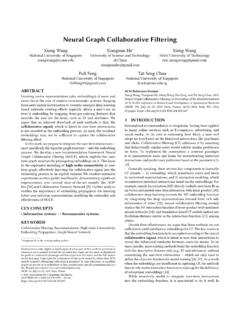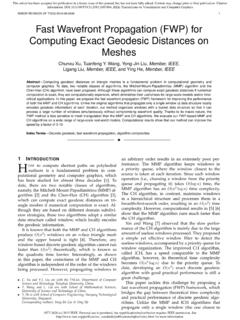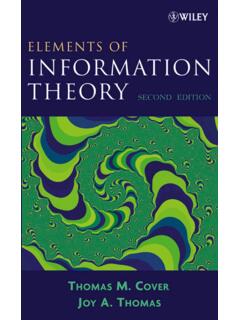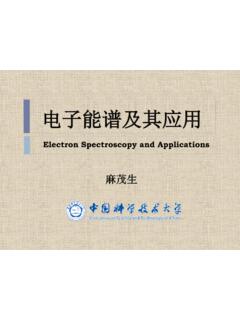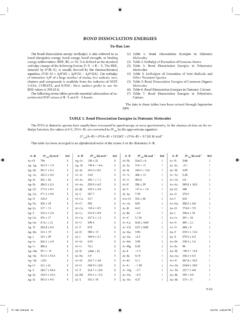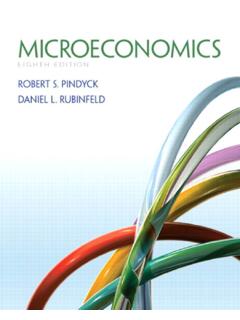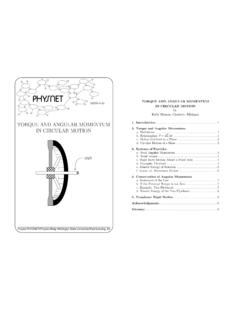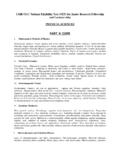Transcription of 16 Statistical thermodynamics 1 - ustc.edu.cn
1 Statisticalthermodynamics 1:the conceptsStatistical thermodynamics provides the link between the microscopic properties of matterand its bulk properties. Two key ideas are introduced in this chapter. The first is the Boltzmanndistribution, which is used to predict the populations of states in systems at thermal equilibrium. In this chapter we see its derivation in terms of the distribution of particles overavailable states. The derivation leads naturally to the introduction of the partition function,which is the central mathematical concept of this and the next chapter. We see how to interpret the partition function and how to calculate it in a number of simple cases. We thensee how to extract thermodynamic information from the partition function.
2 In the final part of the chapter, we generalize the discussion to include systems that are composed of assemblies of interacting particles. Very similar equations are developed to those in the firstpart of the chapter, but they are much more widely preceding chapters of this part of the text have shown how the energy levels of molecules can be calculated, determined spectroscopically, and related to theirstructures. The next major step is to see how a knowledge of these energy levels can be used to account for the properties of matter in bulk. To do so, we now introducethe concepts of Statistical thermodynamics , the link between individual molecularproperties and bulk thermodynamic crucial step in going from the quantum mechanics of individual molecules to the thermodynamics of bulk samples is to recognize that the latter deals with the averagebehaviour of large numbers of molecules.
3 For example, the pressure of a gasdepends on the average force exerted by its molecules, and there is no need to specifywhich molecules happen to be striking the wall at any instant. Nor is it necessary toconsider the fluctuations in the pressure as different numbers of molecules collidewith the wall at different moments. The fluctuations in pressure are very small com-pared with the steady pressure: it is highly improbable that there will be a sudden lullin the number of collisions, or a sudden surge. Fluctuations in other thermodynamicproperties also occur, but for large numbers of particles they are negligible comparedto the mean chapter introduces Statistical thermodynamics in two stages. The first, thederivation of the Boltzmann distribution for individual particles, is of restricted applicability, but it has the advantage of taking us directly to a result of central import-ance in a straightforward and elementary way.
4 We can usestatistical thermodynamicsonce we have deduced the Boltzmann distribution. Then (in Section ) we extendthe arguments to systems composed of interacting distribution of and molecular on biochemistry: The helix coil transition inpolypeptidesThe internal energy and the internal Statistical entropyThe canonical partition canonical thermodynamicinformation in the moleculesChecklist of key ideasFurther readingFurther information : The Boltzmann distributionFurther information : The Boltzmann formulaFurther information :Temperatures below zeroDiscussion AND WEIGHTS561 The distribution of molecular statesWe consider a closed system composed of Nmolecules. Although the total energy isconstant at E, it is not possible to be definite about how that energy is shared betweenthe molecules.
5 Collisions result in the ceaseless redistribution of energy not only between the molecules but also among their different modes of motion. The closestwe can come to a description of the distribution of energy is to report the populationof a state, the average number of molecules that occupy it, and to say that on averagethere are nimolecules in a state of energy i. The populations of the states remainalmost constant, but the precise identities of the molecules in each state may changeat every problem we address in this section is the calculation of the populations of statesfor any type of molecule in any mode of motion at any temperature. The only restric-tion is that the molecules should be independent, in the sense that the total energy of the system is a sum of their individual energies.
6 We are discounting (at this stage)the possibility that in a real system a contribution to the total energy may arise frominteractions between molecules. We also adopt the principle of equal a prioriprob-abilities, the assumption that all possibilities for the distribution of energy are priorimeans in this context loosely as far as one knows . We have no reasonto presume otherwise than that, for a collection of molecules at thermal equilibrium,vibrational states of a certain energy, for instance, are as likely to be populated as rotational states of the same very important conclusion that will emerge from the following analysis is thatthe populations of states depend on a single parameter, the temperature.
7 That is, statist-ical thermodynamics provides a molecular justification for the concept of tempera-ture and some insight into this crucially important and weightsAny individual molecule may exist in states with energies 0, 1,..We shall alwaystake 0, the lowest state, as the zero of energy ( 0=0), and measure all other energiesrelative to that state. To obtain the actual internal energy, U, we may have to add aconstant to the calculated energy of the system. For example, if we are considering thevibrational contribution to the internal energy, then we must add the total zero-pointenergy of any oscillators in the sample.(a) Instantaneous configurationsAt any instant there will be n0molecules in the state with energy 0,n1with 1, and soon.
8 The specification of the set of populations n0,n1,..in the form {n0,n1,..} is astatement of the instantaneous configurationof the system. The instantaneousconfiguration fluctuates with time because the populations change. We can picture alarge number of different instantaneous configurations. One, for example, might be{N,0,0,..}, corresponding to every molecule being in its ground state. Anothermight be {N 2,2,0,0,..}, in which two molecules are in the first excited state. The latter configuration is intrinsically more likely to be found than the former because it can be achieved in more ways: {N,0,0,..} can be achieved in only one way, but {N 2,2,0,..} can be achieved in 1 2N(N 1) different ways (Fig.)
9 ; ). At this stage in the argument, we are ignoring the requirement that the total energy of the system should be constant (the second configuration has a higher energy than the first). The constraint of total energy is imposed later in this a configuration {5,0,0,..} can be achieved in only oneway, a configuration {3,2,0,..} can beachieved in the ten different ways shownhere, where the tinted blocks representdifferent thermodynamics 1: THE CONCEPTSC omment formally, Wis called themultinomial coefficient(seeAppendix2).In eqn , x!,xfactorial, denotes x(x 1)(x 2)..1, and by definition 0!= !6!5!4!N= 18 Fig. 18 molecules shown here canbe distributed into four receptacles(distinguished by the three vertical lines) in 18!
10 Different ways. However, 3! of theselections that put three molecules in thefirst receptacle are equivalent, 6! that putsix molecules into the second receptacle areequivalent, and so on. Hence the numberof distinguishable arrangements is18!/3!6!5!4!.If, as a result of collisions, the system were to fluctuate between the configurations{N,0,0,..} and {N 2,2,0,..}, it would almost always be found in the second,more likely state (especially if Nwere large). In other words, a system free to switch between the two configurations would show properties characteristic almost exclus-ively of the second configuration. A general configuration {n0,n1,..} can be achievedinWdifferent ways, where Wis called the weightof the configuration.
